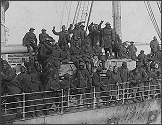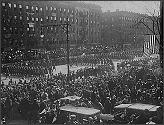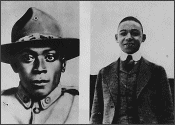
Photographs of the 369th Infantry and African Americans during World War I
Background
While the Great War raged in Europe for three long years, America steadfastly clung to neutrality. It was not until April 2, 1917, that President Wilson asked Congress to declare war on Germany. "The world," he said, "must be made safe for democracy." Quickly, Americans swung into action to raise, equip, and ship the American Expeditionary Force to the trenches of Europe. Under the powers granted to it by the U.S. Constitution (Article I, Section 8) "to raise and support Armies," Congress passed the Selective Service Act of 1917. Among the first regiments to arrive in France, and among the most highly decorated when it returned, was the 369th Infantry (formerly the 15th Regiment New York Guard), more gallantly known as the "Harlem Hellfighters." The 369th was an all-black regiment under the command of mostly white officers including their commander, Colonel William Hayward.
Participation in the war effort was problematic for African Americans. While America was on a crusade to make the world safe for democracy abroad, it was neglecting the fight for equality at home. Plessy v. Ferguson (1896) established that the 14th Amendment allowed for separate but equal treatment under the law. In 1913 President Wilson, in a bow to Southern pressure, even ordered the segregation of federal office workers. The U.S. Army at this time drafted both black and white men, but they served in segregated units. After the black community organized protests, the Army finally agreed to train African American officers but it never put them in command of white troops.
Leaders of the African American community differed in their responses to this crisis. A. Philip Randolph was pessimistic about what the war would mean for black Americans -- he pointed out that Negroes had sacrificed their blood on the battlefields of every American war since the Revolution, but it still had not brought them full citizenship. W.E.B. DuBois argued that "while the war lasts [we should] forget our special grievances and close our ranks shoulder to shoulder with our white fellow citizens and allied nations that are fighting for democracy." And in full force, America's black population "closed ranks."
During World War I 380,000 African Americans served in the wartime Army. Approximately 200,000 of these were sent to Europe. More than half of those sent abroad were assigned to labor and stevedore battalions, but they performed essential duties nonetheless, building roads, bridges, and trenches in support of the front-line battles. Roughly 42,000 saw combat.
American troops arrived in Europe at a crucial moment in the war. Russia had just signed an armistice with Germany in December 1917 freeing Germany to concentrate her troops on the Western Front. If Germany could stage a huge offensive before Americans came to the aid of her war-weary allies, Germany could win the war.
The 369th Infantry helped to repel the German offensive and to launch a counteroffensive. General John J. Pershing assigned the 369th to the 16th Division ofthe French Army. With the French, the Harlem Hellfighters fought at Chateau-Thierry and Belleau Wood. All told they spent 191 days in combat, longer than any other American unit in the war. "My men never retire, they go forward or they die," said Colonel Hayward. Indeed, the 369th was the first Allied unit to reach the Rhine.
The extraordinary valor of the 369th earned them fame in Europe and America. Newspapers headlined the feats of Corporal Henry Johnson and Private Needham Roberts. In May 1918 they were defending an isolated lookout post on the Western Front, when they were attacked by a German unit. Though wounded, they refused to surrender, fighting on with whatever weapons were at hand. They were the first Americans awarded the Croix de Guerre, and they were not the only Harlem Hellfighters to win awards; 171 of its officers and men received individual medals and the unit received a Croix de Guerre for taking Sechault.
In December 1917, when Colonel Hayward's men had departed from New York City, they had not been permitted to participate in the farewell parade of New York's National Guard, the so-called Rainbow division. The reason Hayward was given was that "black is not a color in the Rainbow." Now Colonel Hayward pulled every political string he could to assure his men would be rewarded with a victory parade when they came home in February 1919. Crowds thronged New York City's Fifth Avenue as the 369th marched to the music of their now- famous regimental jazz band leader, James Reese Europe. After the parade, city officials honored the troops at a special dinner. What kind of America had they come home to?
World War I initiated changes on the home front that permanently affected the lives of Americans, black and white. While defense production was up, the war had cut off the flow of immigrant labor. Workers were needed in the North, and African Americans seized the opportunity. Eagerly they left behind a rural South of Jim Crow laws, lynchings, and oppressive economic conditions. The Great Migration -- the most massive internal migration in American history -- brought several million African Americans North before the Depression stemmed its flow. With the migrants, black culture entered the American mainstream, changing it forever. Musical styles never heard before outside the South became "hot." The Jazz Age had begun. The Harlem Renaissance blossomed in one of the nation's greatest artistic outpourings, bringing to the fore a great poet, Langston Hughes.
On the political front, participation in World War I did little to directly advance the equal rights of African Americans. But for many Americans both black and white, it did heighten awareness of the gulf that existed between American rhetoric and reality. After the war A. Philip Randolph was fond of saying to his audiences "I want to congratulate you for doing your bit to make the world safe for democracy . . . and unsafe for hypocrisy."
Resources
Barbeau, Arthur E. and Florette Henri. The Unknown Soldiers: Black American Troops in World War I. Philadelphia: Temple University Press, 1974.
Bennett, Lerone Jr. Before the Mayflower: A History of the Negro in America 1619-1964. Baltimore: Penguin Books, Inc., 1970.
Consider the Source: Historical Records in the Classroom. Albany, NY: The University of the State of New York. The New York State Archives. (10A46 Cultural Education Center, Albany, NY 12230; http://www.archives.nysed.gov). This book includes a letter from one of the officers of the 369th Infantry.
Crew, Spencer R. Field to Factory: Afro-American Migration 1915-1940. Washington DC: Smithsonian Institution, 1987.
Europe, James Reese. "Lieut. James R. Europe's 369th Hell Fighters' Band." Disc: IAJRC 1012 (available from Amazon.com).
Lawrence, Jacob. The Migration Series. Edited by Elizabeth Hutton Turner. Washington, DC: Rappahannock Press, 1993.
Nalty, Bernard C. Strength for the Fight: A History of Black Americans in the Military. New York: The Free Press,1986.
The Documents
New York's famous 369th regiment
arrives home from France

Click to Enlarge
National Archives and Records Administration
Records of the War Department
Record Group 165
National Archives Identifier:
533548
Famous New York soldiers return home

Click to Enlarge
National Archives and Records Administration
Records of the War Department
Record Group 165
National Archives Identifier:
533553
Lt. James Reese Europe, famous jazz
band leader, back with the 369th Regiment

Click to Enlarge
National Archives and Records Administration
Records of the War Department
Record Group 165
National Archives Identifier:
533506
Two American Negroes win Croix de Guerre

Click to Enlarge
National Archives and Records Administration
Records of the War Department
Record Group 165
National Archives Identifier:
533523
Wounded men in parade of the 369th Infantry

Click to Enlarge
National Archives and Records Administration
Records of the War Department
Record Group 165
National Archives Identifier:
533519
Anxious crowds gathered in the streets

Click to Enlarge
National Archives and Records Administration
Records of the War Department
Record Group 165
National Archives Identifier:
533554
Children gather along the line of march

Click to Enlarge
National Archives and Records Administration
Records of the War Department
Record Group 165
National Archives Identifier:
533508